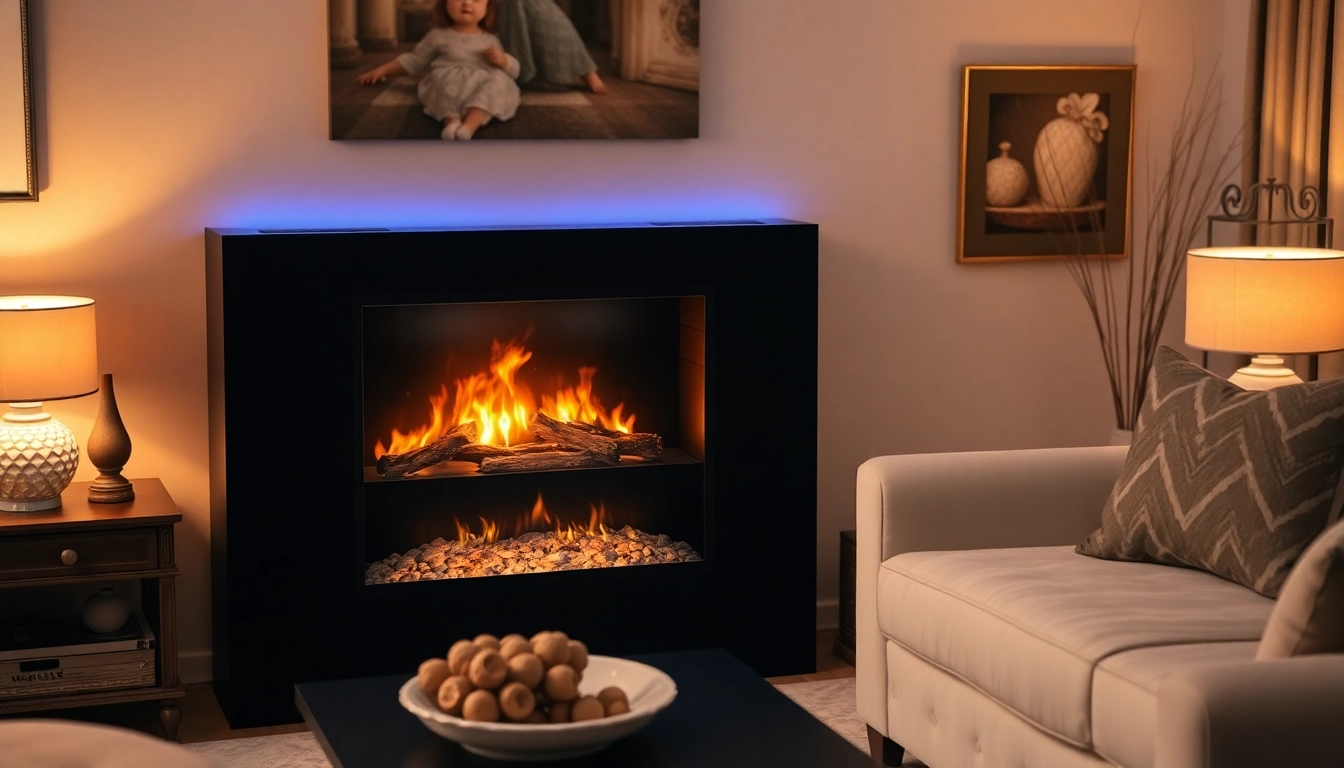The Benefits of Water Vapor Electric Fireplaces
Water vapor electric fireplaces are gaining significant attention as innovative heating solutions that blend ambiance with functionality. Unlike traditional fireplaces, these unique units utilize water vapor technology to simulate the flickering flames of a fire without the associated heat and emissions. This makes them not only visually appealing but also eco-friendly. More homeowners are considering a water vapor electric fireplace for their living spaces, and for good reason. Below, we explore the myriad benefits this technology brings to residential settings.
1. Eco-Friendly Features
The most distinguished feature of water vapor electric fireplaces is their ecological footprint. Traditional fireplaces, whether they burn wood or gas, emit harmful particulates and carbon dioxide into the atmosphere. Water vapor fireplaces, on the other hand, function entirely on electricity and utilize water vapor to produce a realistic flame effect. This means zero emissions are generated during operation, making them an excellent choice for environmentally-conscious homeowners.
Furthermore, many models are designed to be energy-efficient, maintaining low electricity consumption while offering a striking visual display. During warmer months, these fireplaces can serve decorative purposes without adding to the heat load in your home, allowing you to enjoy their ambiance year-round without the environmental guilt.
2. Safety Aspects: Flame-Free and Cool to the Touch
Safety is a paramount concern for any appliance that simulates fire. Traditional fireplaces come with risks, including the potential for burns, fires caused by embers, or accidental contact with hot surfaces. Water vapor electric fireplaces operate using cool-to-the-touch technology, rendering them safe for homes with children and pets. With no real flames and no heat output, these fireplaces can occupy any space without the associated risks typically linked to traditional heating methods.
Moreover, modern water vapor fireplace designs often incorporate features like automatic shut-off mechanisms, maintaining safety even in unattended situations. This comprehensive safety profile makes them a prudent choice for various living environments, from urban apartments to family homes.
3. Year-Round Ambiance without Heat
The ability to enjoy a fireplace aesthetic without generating heat is a compelling advantage of water vapor electric fireplaces. For many, the comforting sight and sound of a crackling fire are fundamental to creating a cozy atmosphere, but heat generation can be excessive in well-insulated modern homes.
Water vapor fireplaces allow you to indulge in the visual appeal of a glowing flame while keeping the home cool. This flexibility is perfect for hot summer nights when you crave the ambiance of a fire without the sweltering heat. Additionally, since they utilize low maintenance water reservoirs, there’s no need to worry about wood storage or gas line installation, making these fireplaces a highly convenient option.
How Water Vapor Electric Fireplaces Work
1. Understanding Ultrasonic Technology
At the heart of water vapor electric fireplaces lies ultrasonic technology. This innovation utilizes high-frequency sound waves to create vapors from water, which are then emitted into the air. The process generates a mist that, when lit with strategically placed LED lights, produces a lifelike flame effect.
This technology effectively mimics real flames while avoiding the hazards associated with traditional combustion methods. The “flames” you see are crafted from tiny water droplets that reflect light, creating an enchanting and realistic fire visual.
2. The Illusion of Real Flames
The combination of nuanced lighting and water vapor creates a mesmerizing effect, making it difficult to distinguish these electric fireplaces from their wood-burning counterparts. Adjustments in light color, intensity, and flame movement can be tailored in advanced models, enhancing the realistic appearance of the flickering flames. Some brands allow users to customize the flame’s height and color, adding even more versatility to a room’s decor.
This level of visual sophistication appeals to homeowners eager to enhance their interior without sacrificing safety or comfort. Design flexibility allows these units to adapt seamlessly to various aesthetic themes, from modern minimalist to rustic charm.
3. Water Consumption and Maintenance
While water vapor electric fireplaces do use water as a core component of their operation, the consumption is minimal. Most models come equipped with water tanks that typically hold enough liquid for several hours of continuous operation. Some units even feature automatic refill capabilities, reducing the need for constant monitoring.
Maintenance generally involves occasional cleaning of the water reservoir and ensuring the ultrasonic components remain free from deposits or debris. Compared to traditional fireplaces, which may require extensive cleaning and annual chimney maintenance, this makes water vapor fireplaces a low-maintenance option that can seamlessly fit into busy lifestyles.
Choosing the Right Water Vapor Electric Fireplace for Your Home
1. Styles and Designs Available
When selecting a water vapor electric fireplace, one of the first considerations is the design and style that best matches your living space. There is a vast array of options available, including wall-mounted units, freestanding models, and fireplace inserts designed to fit into existing structures.
Wall-mounted fireplaces can save space while offering a modern look, ideal for apartments or smaller rooms. Freestanding models provide mobility, allowing homeowners to adjust their setup based on seasonal decor changes or layout modifications. Additionally, insert styles can transform traditional fireplace openings into high-tech visuals without full renovation, giving homeowners the best of both worlds.
2. Size Considerations for Your Space
Size is a critical factor when choosing any fireplace. It’s essential to measure the space where you intend to place the unit accurately. For wall-mounted options, ensure there’s adequate wall space and that the unit aligns with the room’s design.
Freestanding models need sufficient clearance on all sides to ensure both safety and aesthetic balance. Manufacturers typically provide specifications that help guide your selection. Considering both height and width alongside your room’s dimensions can help gauge the optimal size for maintaining visual harmony.
3. Budgeting for Purchase and Installation
Budget considerations for water vapor electric fireplaces can vary widely depending on design, brand, and features. Entry-level models may start around a few hundred dollars, while higher-end variations with advanced technology and customizable features can cost significantly more.
When planning your budget, consider additional costs such as installation (if applicable), potential maintenance, and the cost of electricity for operation. Given their energy-efficient design, you may find considerable savings on heating bills compared to traditional fireplaces, further maximizing the value of your investment.
Installation Guide: Setting Up Your Water Vapor Electric Fireplace
1. Essential Tools and Requirements
Installing a water vapor electric fireplace can be a straightforward process, especially since many models are designed for easy setup. Basic tools may include a screwdriver, level, and measuring tape. It’s also wise to keep on hand a clean cloth for potential assembly clean-up.
Before you begin, ensure that you have the necessary electrical connections and check local building codes for any potential regulations related to fireplace installations.
2. Step-by-Step Installation Process
The installation generally follows these basic steps:
- Choose a Location: Select an optimal spot that aligns with your aesthetic while considering proximity to electrical outlets.
- Mount the Unit: For wall-mounted units, use a level to mark the top and bottom placement points accurately. Secure the brackets and mount the fireplace according to the manufacturer’s instructions.
- Connect Electricity: If required, connect the power supply as per the guidelines. Most models will need direct access to an outlet.
- Fill Water Tank: Fill the water reservoir as instructed, and ensure all components are securely attached.
- Test Run: Power up your new fireplace and verify that everything functions as expected, adjusting settings as necessary to ensure the desired ambiance.
3. Avoiding Common Installation Mistakes
Common pitfalls during installation can lead to performance issues. Here are several mistakes to avoid:
- Ignoring Dimensions: Always double-check measurements to ensure the unit fits appropriately without obstruction.
- Neglecting Power Supply: Ensure an accessible power source exists based on the fireplace’s requirements to avoid extension cords that can pose safety issues.
- Improper Water Filling: Fill the water tank properly according to the specifications to prevent operational failures.
Comparing Water Vapor Electric Fireplaces with Traditional Options
1. Cost-Effectiveness Over Time
While the initial purchase price of a water vapor electric fireplace may sometimes be higher than traditional options, especially wood-burning ones, the ongoing costs can be considerably lower. Traditional fireplaces require regular maintenance, fuel purchases (wood, gas), and often significant space modifications during installation. In contrast, water vapor models offer lower operational costs due to their energy efficiency, often resulting in savings on energy bills, especially in supplemental heating scenarios.
2. Environmental Impact Considerations
Environmental advantages differentiate water vapor electric fireplaces from traditional fireplaces. Traditional units emit harmful pollutants that can affect indoor air quality. In contrast, water vapor electric fireplaces not only generate no emissions but also avoid the need for venting or chimney services. This clean operation renders them suitable for urban environments where air quality concerns are paramount.
3. User Experience and Aesthetic Appeal
The aesthetic appeal of a fireplace significantly enhances the ambience of a space. Water vapor fireplaces offer a high level of customization in appearance, allowing users to orchestrate the flickering patterns and colors to suit different moods or themes. In many cases, they provide a visual experience that actively competes with real flames, offering warmth without the associated risks.
Ultimately, the choice between a traditional fireplace and a water vapor electric fireplace will hinge on individual needs: whether you prioritize aesthetic charm, environmental impact, safety, or operational costs. The rise of water vapor technology aligns beautifully with contemporary values and lifestyles, reflecting a thorough understanding of modern home design.








